|
|
#681 |
|
⊙▃⊙
|
What's in the sky tonight?
September 22, 2013 -The September equinox occurs at 4:44 p.m. EDT today, when the Sun crosses the equator heading south for the season. Fall begins in the Northern Hemisphere, spring in the Southern Hemisphere. -As summer ends, the Sagittarius Teapot moves to the west of south during evening and tips increasingly far over, as if pouring out summer's last drops. -NASA's Solar Dynamics Observatory is monitoring a coronal hole in the sun's northern hemisphere. It is the UV-dark region in this image taken during the early hours of Sept. 21st. The white lines in the image trace the sun's magnetic field. A coronal hole is a place where the magnetic field spreads apart, allowing solar wind to escape. A stream of solar wind flowing from this particular coronal hole is heading for Earth, due to arrive on Sept. 23-24. Its arrival could add to the impact of a minor CME expected to reach Earth at about the same time. Polar geomagnetic storms are possible early next week. 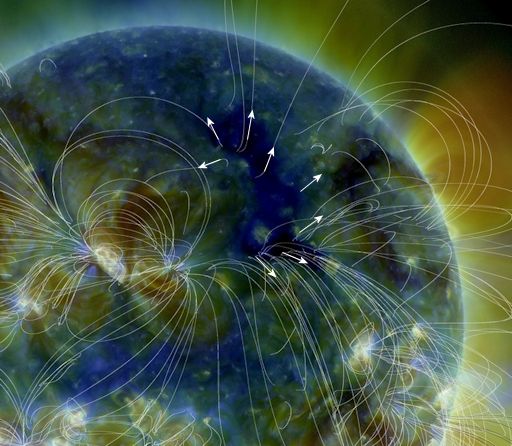 Astro Picture of the Day: September 22, 2013 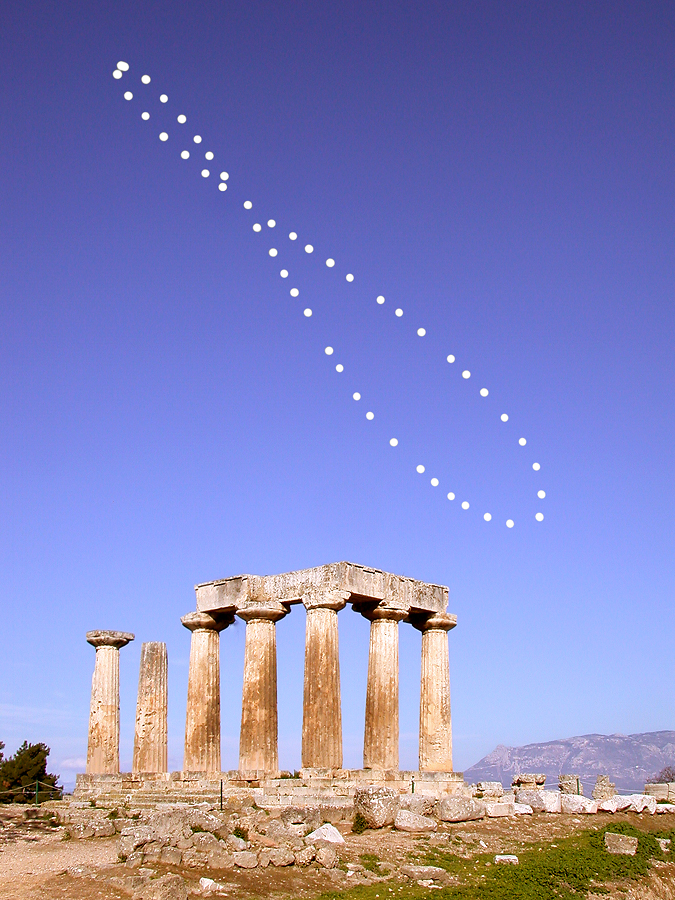 Today, the Sun crosses the celestial equator heading south at 20:44 Universal Time. An equinox (equal night), this astronomical event marks the first day of autumn in the northern hemisphere and spring in the south. With the Sun on the celestial equator, Earth dwellers will experience nearly 12 hours of daylight and 12 hours of darkness. To celebrate, consider this remarkable record of the Sun's yearly journey through planet Earth's sky, made with planned multiple exposures captured on a single piece of 35 millimeter film. Exposures were made at the same time of day (9:00am local time), capturing the Sun's position on dates from January 7 through December 20, 2003. The multiple suns trace an intersecting curve known as an analemma. A foreground base exposure of the Temple of Apollo in ancient Corinth, Greece, appropriate for an analemma, was digitally merged with the film image. Equinox dates correspond to the middle points (not the intersection point) of the analemma. The curve is oriented at the corresponding direction and altitude for the temple, so the Sun's position for the September equinox is at the upper midpoint near picture center. Summer and winter solstices are at analemma top and bottom.
__________________
1st in Kommisar's 2009 SM Tournament 1st in I Love You`s 2009 New Year`s Tournament 3rd in EnR's Mashfest '08 tournament 5th in Phynx's Unofficial FFR Tournament 9th in D3 of the 2008-2009 4th Official FFR Tournament 10th in D5 of the 2010 5th Official FFR Tournament 10th in D6 of the 2011-2012 6th Official FFR Tournament FMO AAA Count: 71 FGO AAA Count: 10 Bluearrowll = The Canadian player who can not detect awkward patterns. If it's awkward for most people, it's normal for Terry. If the file is difficult but super straight forward, he has issues. If he's AAAing a FGO but then heard that his favorite Hockey team was losing by a point, Hockey > FFR PS: Cool AAA's Terry - I Love You An Alarm Clock's Haiku beep beep beep beep beep beep beep beep beep beep beep beep beep beep beep beep beep - ieatyourlvllol |
|
|

|
|
|
#682 |
|
⊙▃⊙
|
What's in the sky tonight?
September 23, 2013 -Altair shines due south very high after dark. It's the leading light of the constellation Aquila, the Eagle. Off the tail of Aquila lies the Scutum Star Cloud, with the grand open cluster M11 just below the dark nebula Barnard 111. -Comet ISON is falling toward the sun for a close encounter on Thanksgiving Day 2013. If it survives, it could become one of the finest comets in years. At the moment ISON is still far away and faint, but its sunward velocity is impressive--more than 72,000 mph on Sept. 22nd. Alberto Quijano Vodniza of Pasto, Narino, Colombia, obtained the 35-minute video on Sept 22nd. "The motion of the comet was clearly visible," he says. "I used a 14-inch Celestron telescope and a STL-1001E SBIG camera." The video can be found here: http://spaceweather.com/gallery/indi...pload_id=86998 Comet ISON is now approaching Mars in the eastern sky before sunrise. On Oct. 1st it will fly past the Red Planet at a distance on only 0.07 AU. Mars satellites and rovers are in position to snap the first close-up pictures of the comet. News Posted Today: September 23, 2013 Is Phaethon a "Rock Comet"?  Astro Picture of the Day: September 23, 2013  South of Antares, in the tail of the nebula-rich constellation Scorpius, lies emission nebula IC 4628. Nearby hot, massive stars, millions of years young, radiate the nebula with invisible ultraviolet light, stripping electrons from atoms. The electrons eventually recombine with the atoms to produce the visible nebular glow, dominated by the red emission of hydrogen. At an estimated distance of 6,000 light-years, the region shown is about 250 light-years across, spanning an area equivalent to four full moons on the sky. The nebula is also cataloged as Gum 56 for Australian astronomer Colin Stanley Gum, but seafood-loving astronomers might know this cosmic cloud as The Prawn Nebula.
__________________
1st in Kommisar's 2009 SM Tournament 1st in I Love You`s 2009 New Year`s Tournament 3rd in EnR's Mashfest '08 tournament 5th in Phynx's Unofficial FFR Tournament 9th in D3 of the 2008-2009 4th Official FFR Tournament 10th in D5 of the 2010 5th Official FFR Tournament 10th in D6 of the 2011-2012 6th Official FFR Tournament FMO AAA Count: 71 FGO AAA Count: 10 Bluearrowll = The Canadian player who can not detect awkward patterns. If it's awkward for most people, it's normal for Terry. If the file is difficult but super straight forward, he has issues. If he's AAAing a FGO but then heard that his favorite Hockey team was losing by a point, Hockey > FFR PS: Cool AAA's Terry - I Love You An Alarm Clock's Haiku beep beep beep beep beep beep beep beep beep beep beep beep beep beep beep beep beep - ieatyourlvllol |
|
|

|
|
|
#683 |
|
⊙▃⊙
|
What's in the sky tonight?
September 24, 2013 -Mercury and Spica are in conjunction just 3/4° apart, very low in the west-southwest in bright twilight. About 20 minutes after sunset, use binoculars to look for them 22° to the lower right of Venus. Mercury is magnitude –0.1. Spica is only a third as bright at magnitude +1.0. -Today is another day that seems more like Solar Min than Solar Max. All of the sunspots on the Earthside of the sun are quiet, and solar activity is low. NOAA forecasters estimate a slim 5% chance of M-class flares on Sept. 24th.  Astro Picture of the Day: September 24, 2013 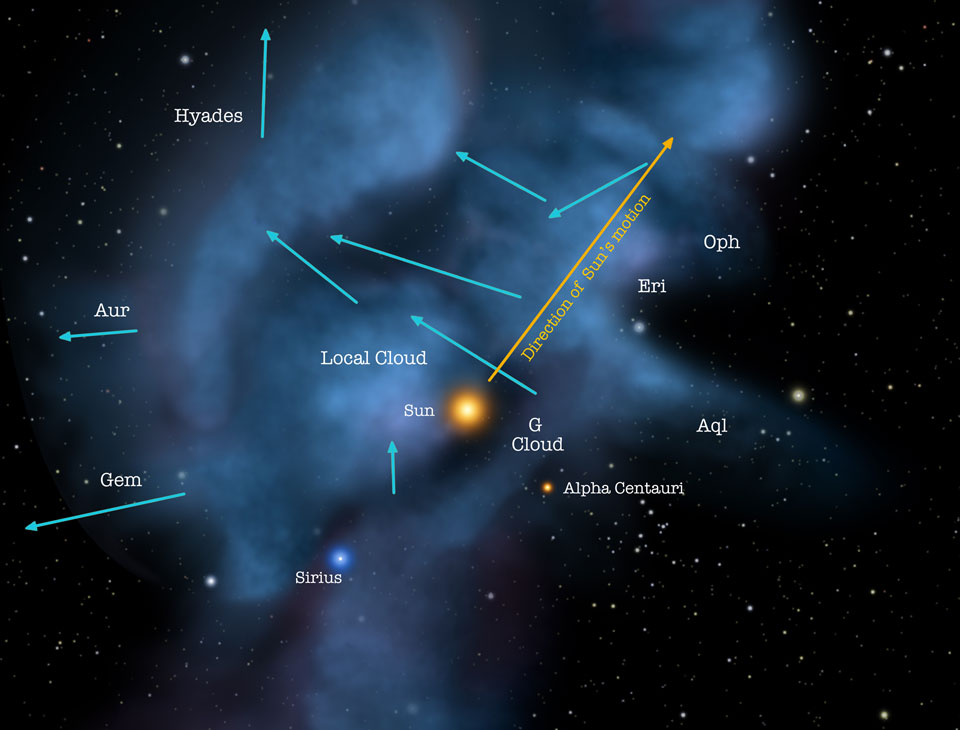 The stars are not alone. In the disk of our Milky Way Galaxy about 10 percent of visible matter is in the form of gas, called the interstellar medium (ISM). The ISM is not uniform, and shows patchiness even near our Sun. It can be quite difficult to detect the local ISM because it is so tenuous and emits so little light. This mostly hydrogen gas, however, absorbs some very specific colors that can be detected in the light of the nearest stars. A working map of the local ISM within 20 light-years, based on ongoing observations and recent particle detections from the Earth-orbiting Interstellar Boundary Exporer satellite (IBEX), is shown above. These observations indicate that our Sun is moving through a Local Interstellar Cloud as this cloud flows outwards from the Scorpius-Centaurus Association star forming region. Our Sun may exit the Local Cloud, also called the Local Fluff, during the next 10,000 years. Much remains unknown about the local ISM, including details of its distribution, its origin, and how it affects the Sun and the Earth. Unexpectedly, recent IBEX spacecraft measurements indicate that the direction from which neutral interstellar particles flow through our Solar System is changing.
__________________
1st in Kommisar's 2009 SM Tournament 1st in I Love You`s 2009 New Year`s Tournament 3rd in EnR's Mashfest '08 tournament 5th in Phynx's Unofficial FFR Tournament 9th in D3 of the 2008-2009 4th Official FFR Tournament 10th in D5 of the 2010 5th Official FFR Tournament 10th in D6 of the 2011-2012 6th Official FFR Tournament FMO AAA Count: 71 FGO AAA Count: 10 Bluearrowll = The Canadian player who can not detect awkward patterns. If it's awkward for most people, it's normal for Terry. If the file is difficult but super straight forward, he has issues. If he's AAAing a FGO but then heard that his favorite Hockey team was losing by a point, Hockey > FFR PS: Cool AAA's Terry - I Love You An Alarm Clock's Haiku beep beep beep beep beep beep beep beep beep beep beep beep beep beep beep beep beep - ieatyourlvllol |
|
|

|
|
|
#684 |
|
Banned
Join Date: Apr 2012
Posts: 1,907
|
check this thread every day. still awesome as hell. never stop!
|
|
|

|
|
|
#685 |
|
⊙▃⊙
|
What's in the sky tonight?
September 25, 2013 -The Moon rises late this evening (around 11 p.m. depending on your location), with Aldebaran well to its upper right and brighter Capella farther to its upper left. Earlier, spot these two stars when they're low to judge where the Moon will rise. -Near the center of the solar disk, growing sunspot AR1850 directly faces Earth. However, like all the other spots on the sun today, AR1850 is quiet and not flaring. The chance of a geoeffective flare today is low. -Amateur astronomers around the world are photographing Comet ISON as it approaches Mars in the predawn sky. The comet is not as bright as some forecasters expected. What does that mean for ISON's future prospects? The answer may be found below this color photo of the comet obtained by UK astronomer Damian Peach on Sept. 24th. At the moment, Comet ISON is about as bright as a 14th magnitude star, which puts it one or two magnitudes dimmer than forecasts. Nevertheless, according to several experts speaking in a NASA video, Comet ISON is still on track to become an impressive sungrazer. John Bortle predicts ISON will rival Venus during the hours leading up to its closest approach to the Sun in November, while Matthew Knight notes that Comet ISON is brighter than Comet Lovejoy was at the same distance from the sun in 2011. Comet Lovejoy went on to become a spectacular naked-eye object. Comet ISON might do the same. The second comet below is a picture of Comet Lovejoy at its peak, which was only visible to the Southern Hemisphere. 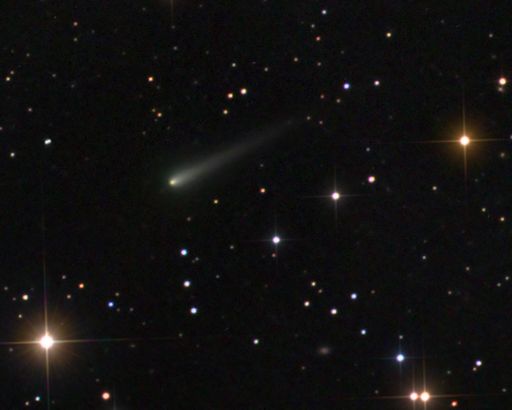  Astro Picture of the Day: September 25, 2013 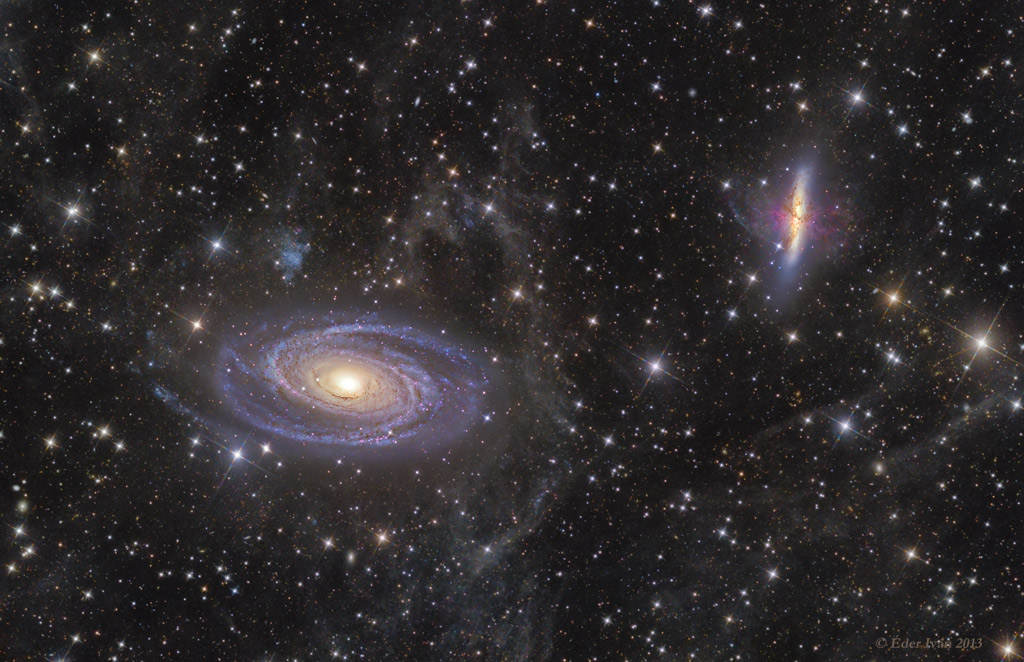 Here in the Milky Way galaxy we have astronomical front row seats as M81 and M82 face-off, a mere 12 million light-years away. Locked in a gravitational struggle for the past billion years or so, the two bright galaxies are captured in this deep telescopic snapshot, constructed from 25 hours of image data. Their most recent close encounter likely resulted in the enhanced spiral arms of M81 (left) and violent star forming regions in M82 so energetic the galaxy glows in X-rays. After repeated passes, in a few billion years only one galaxy will remain. From our perspective, this cosmic moment is seen through a foreground veil of the Milky Way's stars and clouds of dust. Faintly reflecting the foreground starlight, the pervasive dust clouds are relatively unexplored galactic cirrus, or integrated flux nebulae, only a few hundred light-years above the plane of the Milky Way.
__________________
1st in Kommisar's 2009 SM Tournament 1st in I Love You`s 2009 New Year`s Tournament 3rd in EnR's Mashfest '08 tournament 5th in Phynx's Unofficial FFR Tournament 9th in D3 of the 2008-2009 4th Official FFR Tournament 10th in D5 of the 2010 5th Official FFR Tournament 10th in D6 of the 2011-2012 6th Official FFR Tournament FMO AAA Count: 71 FGO AAA Count: 10 Bluearrowll = The Canadian player who can not detect awkward patterns. If it's awkward for most people, it's normal for Terry. If the file is difficult but super straight forward, he has issues. If he's AAAing a FGO but then heard that his favorite Hockey team was losing by a point, Hockey > FFR PS: Cool AAA's Terry - I Love You An Alarm Clock's Haiku beep beep beep beep beep beep beep beep beep beep beep beep beep beep beep beep beep - ieatyourlvllol |
|
|

|
|
|
#686 |
|
⊙▃⊙
|
What's in the sky tonight?
September 26, 2013 -Last-quarter Moon tonight (exact at 11:55 p.m. EDT). The Moon rises around 11 or midnight local time, shining in the feet of Gemini. Jupiter is to its lower left, as shown below, and Orion is farther to its right. -A filament of magnetism curling over the sun's northeastern limb erupted on Sept. 24th around 20:30 UT. NASA's Solar Dynamics Observatory caught the structure hurling part of itself into space. A "canyon of fire" forms as the filament cuts through the sun's lower atmosphere. The glowing walls of the canyon trace the original channel where the filament was suspended by magnetic forces above the stellar surface. -As erupting magnetic filaments often do, this one launched a coronal mass ejection (CME) into space. The cloud does not appear to be heading for Earth.  Astro Picture of the Day: September 26, 2013 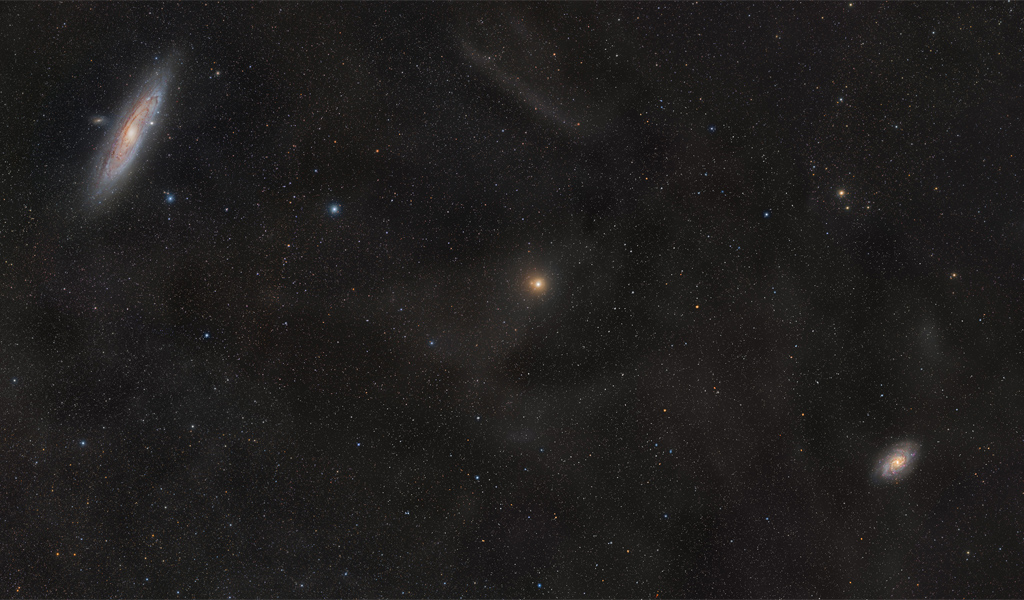 Separated by about 14 degrees (28 Full Moons) in planet Earth's sky, spiral galaxies M31 ,left, and M33 are both large members of the Local Group, along with our own Milky Way galaxy. This wide-angle, telescopic mosaic captures colorful details of spiral structure in both, while the massive neighboring galaxies seem to be balanced either side of bright Mirach, beta star in the constellation Andromeda. But M31, the Andromeda Galaxy, is really 2.5 million light-years distant and M33, the Triangulum Galaxy, is also about 3 million light years away. Mirach, just 200 light-years from the Sun, lies well within the Milky Way, along with the dim clouds of dust drifting through the frame only a few hundred light-years above the galactic plane. Although they look far apart, M31 and M33 are locked in a mutual gravitational embrace. Radio astronomers have found indications of a bridge of neutral hydrogen gas that could connect the two, evidence of a closer encounter in the past. Based on measurements, gravitational simulations currently predict that the Milky Way, M31, and M33 will all undergo mutual close encounters and potentially mergers, billions of years in the future.
__________________
1st in Kommisar's 2009 SM Tournament 1st in I Love You`s 2009 New Year`s Tournament 3rd in EnR's Mashfest '08 tournament 5th in Phynx's Unofficial FFR Tournament 9th in D3 of the 2008-2009 4th Official FFR Tournament 10th in D5 of the 2010 5th Official FFR Tournament 10th in D6 of the 2011-2012 6th Official FFR Tournament FMO AAA Count: 71 FGO AAA Count: 10 Bluearrowll = The Canadian player who can not detect awkward patterns. If it's awkward for most people, it's normal for Terry. If the file is difficult but super straight forward, he has issues. If he's AAAing a FGO but then heard that his favorite Hockey team was losing by a point, Hockey > FFR PS: Cool AAA's Terry - I Love You An Alarm Clock's Haiku beep beep beep beep beep beep beep beep beep beep beep beep beep beep beep beep beep - ieatyourlvllol Last edited by Bluearrowll; 09-26-2013 at 07:17 AM.. |
|
|

|
|
|
#687 |
|
⊙▃⊙
|
What's in the sky tonight?
September 27, 2013 -The Moon, a day past last quarter, rises by 1 a.m. tonight (Saturday morning the 28th), with Jupiter shining to its upper left as shown here. Can you spot Delta Geminorum, magnitude 3.6, just ½° below Jupiter? -For reasons reseachers don't fully understand, auroras love equinoxes. At this time of year, even small gusts of solar wind can spark colorful lights around the poles. On Thursday, the aurora australis appeared over South Arm, Tasmania. "I captured this image from Betsey Island," says photographer Luke O'Brien. "This is a 30 second exposure at ISO 2500. " The solar wind blowing past Earth today is relatively slow, only ~350 km/s. As a result, NOAA forecasters estimate a slim 5% chance of polar geomagnetic storms. That might be enough, however, for more equinox auroras. -The weakest Solar Max in 100 years continues today with another 24 hours of quiet. None of the sunspots on the Earthside of the sun are actively flaring.  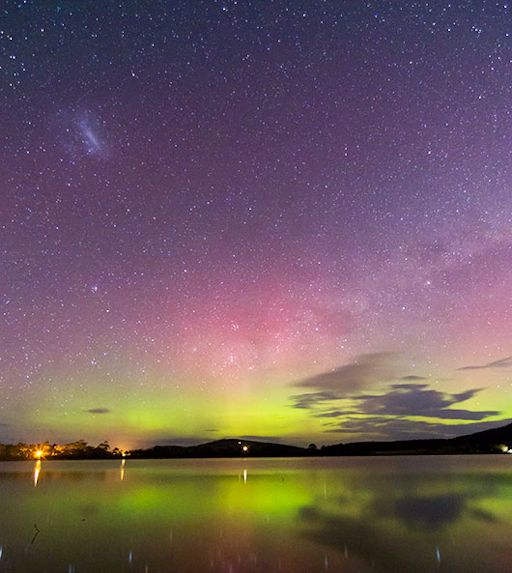 Astro Picture of the Day: September 27, 2013 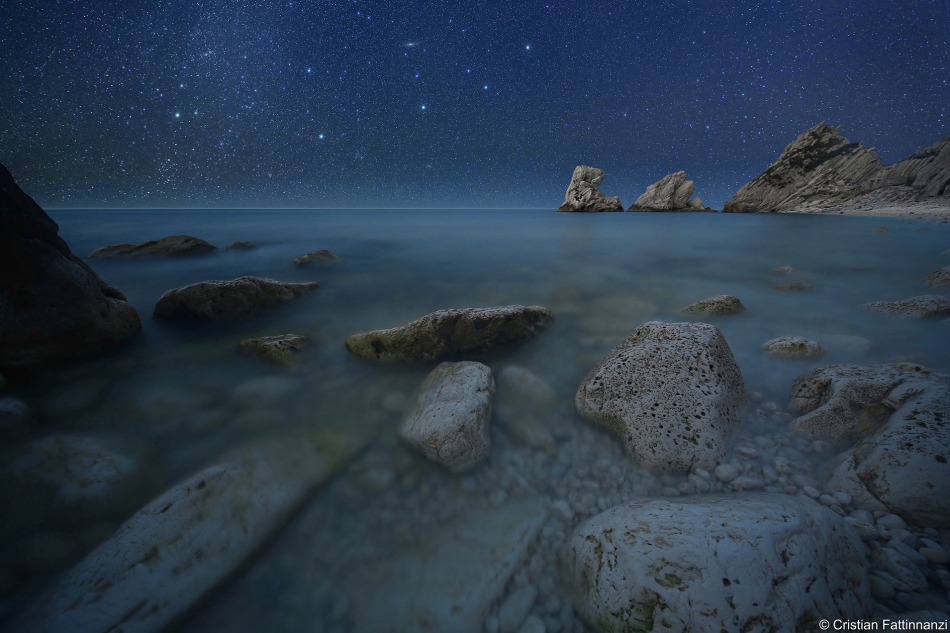 How far can you see? The Andromeda Galaxy 2.5 million light years away is the most distant object easily seen by the unaided eye. Other apparent denizens of the night sky, stars, clusters, and nebulae, typically range from a few hundred to a few thousand light-years away and lie well within our own Milky Way Galaxy. Also known as M31, the Andromeda Galaxy is the faint smudge near top center of this Earth and skyscape, taken from eastern Italy, near Monte Conero on the Adriatic sea coast. From a few centimeters to a few million light-years, the picture demonstrates a stunning range of vision. Though galaxy and seaside rocks could be seen with the eye on that clear summer night, no camera captured this view in a single exposure. Because the stars trailed above the horizon while the picture was made, separate exposures tracking the stars were combined with one of rocks and cliffs made with the camera steadied to create the tantalizing scene.
__________________
1st in Kommisar's 2009 SM Tournament 1st in I Love You`s 2009 New Year`s Tournament 3rd in EnR's Mashfest '08 tournament 5th in Phynx's Unofficial FFR Tournament 9th in D3 of the 2008-2009 4th Official FFR Tournament 10th in D5 of the 2010 5th Official FFR Tournament 10th in D6 of the 2011-2012 6th Official FFR Tournament FMO AAA Count: 71 FGO AAA Count: 10 Bluearrowll = The Canadian player who can not detect awkward patterns. If it's awkward for most people, it's normal for Terry. If the file is difficult but super straight forward, he has issues. If he's AAAing a FGO but then heard that his favorite Hockey team was losing by a point, Hockey > FFR PS: Cool AAA's Terry - I Love You An Alarm Clock's Haiku beep beep beep beep beep beep beep beep beep beep beep beep beep beep beep beep beep - ieatyourlvllol |
|
|

|
|
|
#688 |
|
⊙▃⊙
|
What's in the sky tonight?
September 28, 2013 -This is the time of year when, in mid-evening, W-shaped Cassiopeia stands on end halfway up the northeastern sky. And whenever that happens, the dim Little Dipper extends straight leftward from Polaris due north. -On Sept. 25th, China's experimental Tiangong-1 space station passed directly in front of the sun over Arizona. Mike Weasner held his iPhone 5s up to the eyepiece of a solar-filtered 8" telescope and captured this picture of the spit-second transit. "The Tiangong-1 space station is about 10 meters by 3 meters in size and was 510.4 kilometers from my observatory at the time of the transit," says Weasner. "The angular diameter of the station was only 4.4 arcsec. Yes, that's small!" Weasner used CalSky to predict the moment of transit. "I began slo-mo video recording with the iOS 7 Camera app on the iPhone 5s at 095015 MST and continued it for one minute to ensure that I captured the space station," he says. "The Tiangong-1 was successfully imaged on several frames as it crossed the sun's disk." Most readers are familiar with the 450-ton International Space Station. Fewer may be aware of China's 8.5-ton Tiangong-1 (Heavenly Palace-1). It was launched in Sept. 2011 to establish a foothold in Earth orbit for China's fledgling space program. Since then taikonauts (Chinese astronauts) have visited the Tiangong-1 to practice rendevous and docking procedures and to train for living in space. According to some reports, the Tiangong-1 will be de-orbited in late 2013 to make way for more advanced experimental stations, Tiangong-2 and Tiangong-3 in the years ahead. Ultimately, China hopes to place an Mir-class station in orbit by 2020.  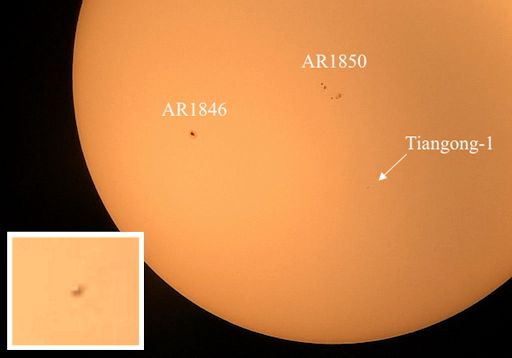 Astro Picture of the Day: September 28, 2013  From a geostationary orbit 36,000 kilometers above the equator, Russian meteorological satellite Elektro-L takes high-resolution images our fair planet every 30 minutes. But only twice a year, during an Equinox, can it capture an image like this one, showing an entire hemisphere bathed in sunlight. At an Equinox, the Earth's axis of rotation is not tilted toward or away from the Sun, so the solar illumination can extend to both the planet's poles. Of course, this Elektro-L picture was recorded on September 22nd, at the northern hemisphere's autumnal equinox. For a moment on that date, the Sun was behind the geostationary satellite and a telltale glint of reflected sunlight is seen crossing the equator, at the location on the planet with satellite and sun directly overhead. This gif is shown below. 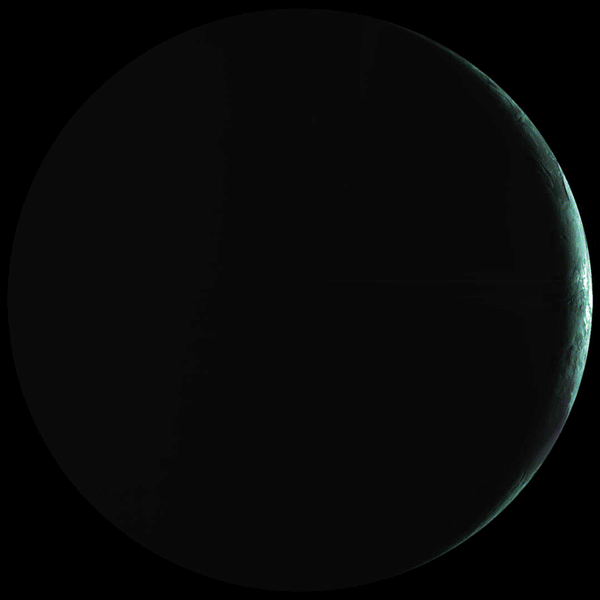
__________________
1st in Kommisar's 2009 SM Tournament 1st in I Love You`s 2009 New Year`s Tournament 3rd in EnR's Mashfest '08 tournament 5th in Phynx's Unofficial FFR Tournament 9th in D3 of the 2008-2009 4th Official FFR Tournament 10th in D5 of the 2010 5th Official FFR Tournament 10th in D6 of the 2011-2012 6th Official FFR Tournament FMO AAA Count: 71 FGO AAA Count: 10 Bluearrowll = The Canadian player who can not detect awkward patterns. If it's awkward for most people, it's normal for Terry. If the file is difficult but super straight forward, he has issues. If he's AAAing a FGO but then heard that his favorite Hockey team was losing by a point, Hockey > FFR PS: Cool AAA's Terry - I Love You An Alarm Clock's Haiku beep beep beep beep beep beep beep beep beep beep beep beep beep beep beep beep beep - ieatyourlvllol |
|
|

|
|
|
#689 |
|
⊙▃⊙
|
What's in the sky tonight?
September 29, 2013 -Watch a Rocket Launch at 12:00PM EST: http://www.spacex.com/webcast/ With the launch of the hybrid small satellite CASSIOPE, scheduled for 2013, Canada will make a significant contribution to unraveling the mysteries of space weather. To accomplish this feat, the satellite will use a dedicated scientific payload ePOP (enhanced polar outflow probe), which will observe the ionosphere. -Arcturus is shining ever lower in the west after dusk as autumn proceeds. Some time around 9 p.m., depending on how far east or west you live in your time zone, Arcturus sinks to the same altitude in the west as Capella has risen to in the northeast. How accurately can you time this event? It happens 4 minutes earlier each day.   Astro Picture of the Day: September 29, 2013  The dust sculptures of the Eagle Nebula are evaporating. As powerful starlight whittles away these cool cosmic mountains, the statuesque pillars that remain might be imagined as mythical beasts. Pictured above is one of several striking dust pillars of the Eagle Nebula that might be described as a gigantic alien fairy. This fairy, however, is ten light years tall and spews radiation much hotter than common fire. The greater Eagle Nebula, M16, is actually a giant evaporating shell of gas and dust inside of which is a growing cavity filled with a spectacular stellar nursery currently forming an open cluster of stars. The above image in scientifically re-assigned colors was released in 2005 as part of the fifteenth anniversary celebration of the launch of the Hubble Space Telescope.
__________________
1st in Kommisar's 2009 SM Tournament 1st in I Love You`s 2009 New Year`s Tournament 3rd in EnR's Mashfest '08 tournament 5th in Phynx's Unofficial FFR Tournament 9th in D3 of the 2008-2009 4th Official FFR Tournament 10th in D5 of the 2010 5th Official FFR Tournament 10th in D6 of the 2011-2012 6th Official FFR Tournament FMO AAA Count: 71 FGO AAA Count: 10 Bluearrowll = The Canadian player who can not detect awkward patterns. If it's awkward for most people, it's normal for Terry. If the file is difficult but super straight forward, he has issues. If he's AAAing a FGO but then heard that his favorite Hockey team was losing by a point, Hockey > FFR PS: Cool AAA's Terry - I Love You An Alarm Clock's Haiku beep beep beep beep beep beep beep beep beep beep beep beep beep beep beep beep beep - ieatyourlvllol |
|
|

|
|
|
#690 |
|
⊙▃⊙
|
What's in the sky tonight?
September 30, 2013 -In the eastern dawn Tuesday morning, look for the thin waning crescent Moon forming a triangle with Mars and Regulus, as shown below. Best view: at least an hour before your local sunrise. -On Sept. 27th, a meteor exploded in the skies above the US midwest. Witnesses report shadows cast upon the ground, unusual sounds, and a swirling contrail marking the aftermath of the blast. "It was the most brilliant fireball that I have ever seen!" reports Angela McClain, who sends this picture from Faith Ranch in Jewett, Ohio. "The entire landscape lit up," she continues. "I spun around and there it was, a huge, bright green light, streaking across the sky. Even when it was gone, there was still a bright line in the sky about 20 seconds later. We were all stunned." "This was a very bright event," says Bill Cooke of NASA's Meteoroid Environment Office. "Flares saturated our meteor cameras, and made determination of the end point (the terminus of the fireball's flight through the atmosphere) virtually impossible. Judging from the brightness, we are dealing with a meter class object." Data from multiple cameras shows that the meteoroid hit Earth's atmosphere traveling 51 km/s (114,000 mph) and passed almost directly over Columbus, Ohio. Cooke has prepared a preliminary map of the ground track. According to the American Meteor Society, the fireball was visible from at least 14 US states.  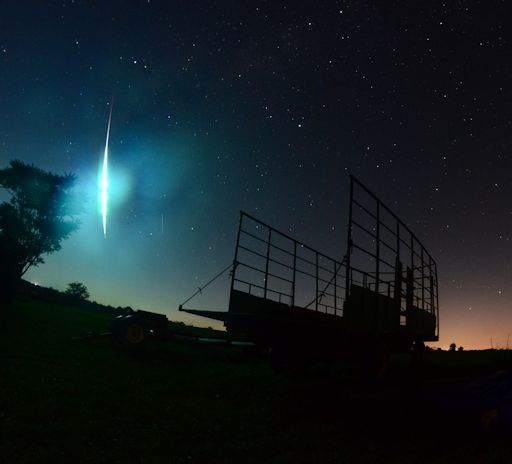 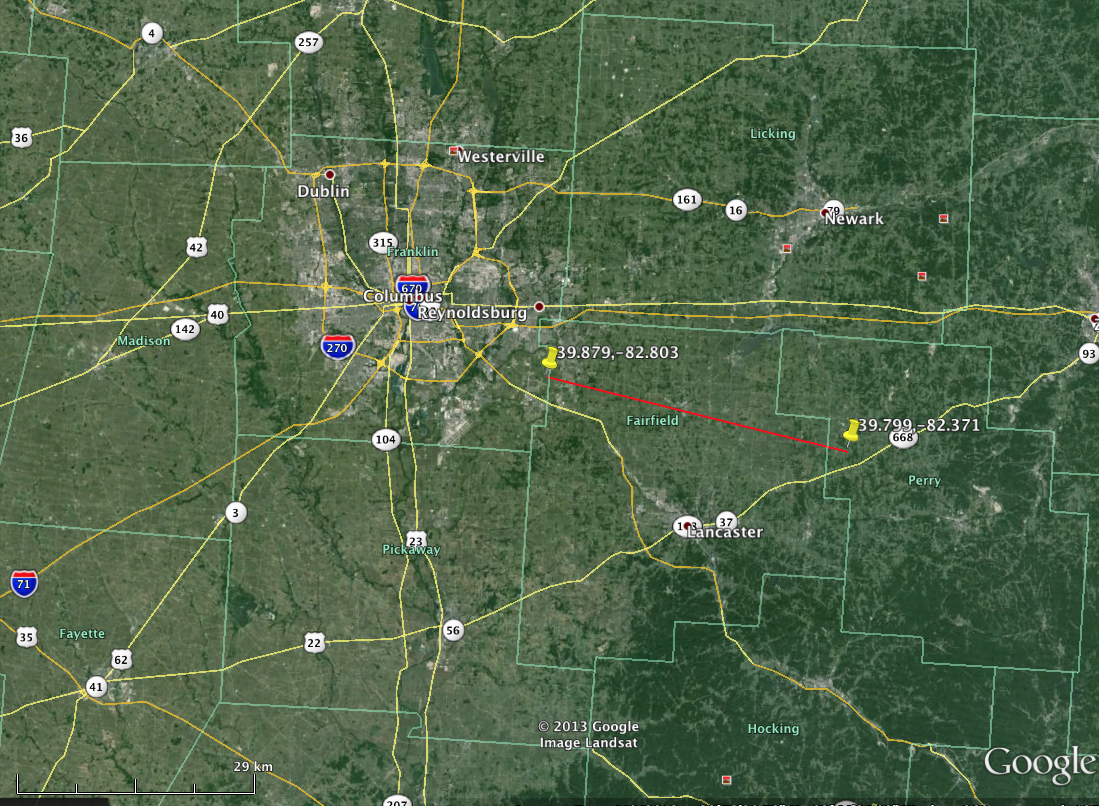 Astro Picture of the Day: September 30, 2013 What is it? Some surely natural phenomenon has appeared in a video that, so far, has defied clear identification. The above time-lapse video was made to record Perseid meteors above Hopewell Rocks in New Brunswick, Canada late this summer. The video, which ran from 9:30 pm August 11 to 3:00 am the next morning, records several meteor and satellite streaks beyond a picturesque background. Each image records a 30 second exposure. At about 25 seconds into the video, however, an unusual patchy green glow appears to cover the sky. Possible explanations include airglow, aurora, lighting from an artificial or natural source, or something completely different.
__________________
1st in Kommisar's 2009 SM Tournament 1st in I Love You`s 2009 New Year`s Tournament 3rd in EnR's Mashfest '08 tournament 5th in Phynx's Unofficial FFR Tournament 9th in D3 of the 2008-2009 4th Official FFR Tournament 10th in D5 of the 2010 5th Official FFR Tournament 10th in D6 of the 2011-2012 6th Official FFR Tournament FMO AAA Count: 71 FGO AAA Count: 10 Bluearrowll = The Canadian player who can not detect awkward patterns. If it's awkward for most people, it's normal for Terry. If the file is difficult but super straight forward, he has issues. If he's AAAing a FGO but then heard that his favorite Hockey team was losing by a point, Hockey > FFR PS: Cool AAA's Terry - I Love You An Alarm Clock's Haiku beep beep beep beep beep beep beep beep beep beep beep beep beep beep beep beep beep - ieatyourlvllol |
|
|

|
|
|
#691 |
|
⊙▃⊙
|
What's in the sky tonight?
October 1, 2013 -Now that October is here, the little fall constellation Aries is visible in the east-northeast after dark and all through the evening. Its two or three brightest stars are lined up roughly horizontally, well below the stars of Andromeda. -Today, October 1st, Comet ISON will fly by Mars at a distance of only 0.07 AU. Red Planet satellites and rovers have a ringside seat for the flyby, and they will be snapping pictures despite a shutdown of the US government. (Apparently, Curiosity has been designated "essential personnel.")  Astro Picture of the Day: October 1, 2013  The explosion is over but the consequences continue. About eleven thousand years ago a star in the constellation of Vela could be seen to explode, creating a strange point of light briefly visible to humans living near the beginning of recorded history. The outer layers of the star crashed into the interstellar medium, driving a shock wave that is still visible today. A roughly spherical, expanding shock wave is visible in X-rays. The above image captures some of that filamentary and gigantic shock in visible light. As gas flies away from the detonated star, it decays and reacts with the interstellar medium, producing light in many different colors and energy bands. Remaining at the center of the Vela Supernova Remnant is a pulsar, a star as dense as nuclear matter that rotates completely around more than ten times in a single second.
__________________
1st in Kommisar's 2009 SM Tournament 1st in I Love You`s 2009 New Year`s Tournament 3rd in EnR's Mashfest '08 tournament 5th in Phynx's Unofficial FFR Tournament 9th in D3 of the 2008-2009 4th Official FFR Tournament 10th in D5 of the 2010 5th Official FFR Tournament 10th in D6 of the 2011-2012 6th Official FFR Tournament FMO AAA Count: 71 FGO AAA Count: 10 Bluearrowll = The Canadian player who can not detect awkward patterns. If it's awkward for most people, it's normal for Terry. If the file is difficult but super straight forward, he has issues. If he's AAAing a FGO but then heard that his favorite Hockey team was losing by a point, Hockey > FFR PS: Cool AAA's Terry - I Love You An Alarm Clock's Haiku beep beep beep beep beep beep beep beep beep beep beep beep beep beep beep beep beep - ieatyourlvllol |
|
|

|
|
|
#692 |
|
⊙▃⊙
|
Sorry guys, it appears that the US Government Shutdown has closed several sources I use to gather information on a daily basis. apod.nasa.gov is the site where most of my pictures of the day come from, and it is closed until further notice. This means until otherwise, I don't have a back up copy of my previous pictures of the day. I'll try to keep the thread running through the downtime but it will take longer to find suitable content that has not been repeated. Especially since some of the satellites and instruments have been shut off that I get photos from.
Other sections affected severely affected: -International Space Station Tracker -Links -Noctilucent Clouds Tracker -Upcoming Events [somewhat] What's in the sky tonight? October 2, 2013 -Have you ever seen the "false dawn," the morning zodiacal light? This is sunlight reflected from interplanetary dust orbiting in the plane of the solar system. The next two weeks offer a fine opportunity for Northern Hemisphere skywatchers.  News Posted Today: October 1, 2013 Uranus's Unlikely Companion  Astro Picture of the Day: October 2, 2013  Lake Tekapo on South Island in New Zealand is arguably one of best night sky locations in the Southern Hemisphere. The significance of its pristine night sky without light pollution is recognised world-wide and is being designateds as an International Dark Sky Reserve as part of a UNESCO-supported initiative to preserve the quality of the night sky and its cultural, scientific, or natural values. This photo was taken by Alex Cherney, a hobbyist astronomer who nicely frames earthly clouds below with celestial clouds above.
__________________
1st in Kommisar's 2009 SM Tournament 1st in I Love You`s 2009 New Year`s Tournament 3rd in EnR's Mashfest '08 tournament 5th in Phynx's Unofficial FFR Tournament 9th in D3 of the 2008-2009 4th Official FFR Tournament 10th in D5 of the 2010 5th Official FFR Tournament 10th in D6 of the 2011-2012 6th Official FFR Tournament FMO AAA Count: 71 FGO AAA Count: 10 Bluearrowll = The Canadian player who can not detect awkward patterns. If it's awkward for most people, it's normal for Terry. If the file is difficult but super straight forward, he has issues. If he's AAAing a FGO but then heard that his favorite Hockey team was losing by a point, Hockey > FFR PS: Cool AAA's Terry - I Love You An Alarm Clock's Haiku beep beep beep beep beep beep beep beep beep beep beep beep beep beep beep beep beep - ieatyourlvllol Last edited by Bluearrowll; 10-2-2013 at 07:46 AM.. |
|
|

|
|
|
#693 |
|
⊙▃⊙
|
What's in the sky tonight?
October 3, 2013 -Jupiter is up in the east by midnight or 1 a.m. and climbs higher until dawn Friday morning. Tonight it's just 0.1° from Delta Geminorum, magnitude 3.5 (you may need binoculars). Delta Gem is more than a magnitude brighter than Ganymede, Jupiter's brightest satellite much closer in. -As Comet ISON passes Mars en route to the sun this week, the comet is still faint. Nevertheless, many experts believe the comet is on track to become a bright sungrazer in late November. Astronomer Ignacio Ferrin of the University of Antioquia Institute of Physics in Colombia disagrees. Ferrin believes Comet ISON is about to disintegrate. The light curve of ISON, he argues, resembles the light curves of other comets that have have fallen apart. If he's right, the "Comet of the Century" could turn into a century-class disappointment. -A CME hit Earth's magnetic field during the early hours of October 2nd, sparking a G2-class geomagnetic storm. In North America, auroras spilled across the Canadian border into more than a dozen northern-tier US states. -The storm has subsided now, but it could flare up again. NOAA forecasters estimate a 50% chance of more polar geomagnetic storms as Earth passes through the wake of the CME on Oct. 3rd. NOAA forecasters working through the government shutdown estimated an almost-even 45% chance of polar geomagnetic storms when the CME arrived. The CME justified those relatively high odds, sparking a G2-class geomagnetic storm around the poles. Astro Picture of the Day: October 3, 2013  You don't have to live in a high latitude to experience a great show from the auroras, but it sure helps. The CME that hit Earth's magnetic field today left the sun on Sept. 30th, propelled by an erupting magnetic filament. The CME was impressive, but the underlying explosion was even more so. One movie from NASA's Solar Dynamics Observatory shows the self-destructing filament in the context of the whole sun. This movie is shown below. The above photo was taken by Monika Petersen on October 2, 2013 at Williams Lake, BC, Canada. With a G2 class magnetic storm, the northern lights would have been visible not only to the north, but also to the east, west, and directly above that location. 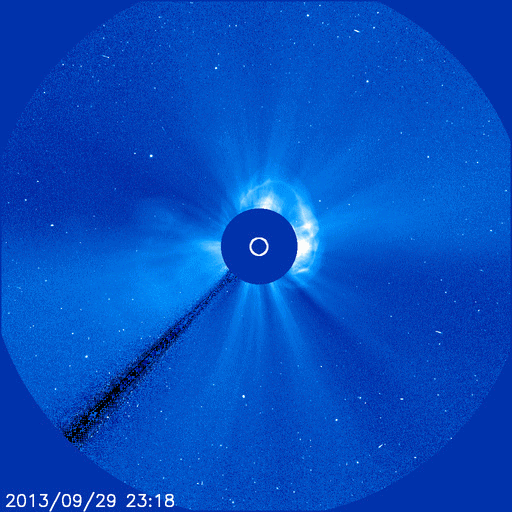
__________________
1st in Kommisar's 2009 SM Tournament 1st in I Love You`s 2009 New Year`s Tournament 3rd in EnR's Mashfest '08 tournament 5th in Phynx's Unofficial FFR Tournament 9th in D3 of the 2008-2009 4th Official FFR Tournament 10th in D5 of the 2010 5th Official FFR Tournament 10th in D6 of the 2011-2012 6th Official FFR Tournament FMO AAA Count: 71 FGO AAA Count: 10 Bluearrowll = The Canadian player who can not detect awkward patterns. If it's awkward for most people, it's normal for Terry. If the file is difficult but super straight forward, he has issues. If he's AAAing a FGO but then heard that his favorite Hockey team was losing by a point, Hockey > FFR PS: Cool AAA's Terry - I Love You An Alarm Clock's Haiku beep beep beep beep beep beep beep beep beep beep beep beep beep beep beep beep beep - ieatyourlvllol |
|
|

|
|
|
#694 |
|
⊙▃⊙
|
What's in the sky tonight?
October 4, 2013 -Even as the stars begin to come out in twilight, Cassiopeia is already higher now in the northeast than the sinking Big Dipper is in the northwest. And Cassiopeia's broad W pattern is almost standing on end. -New Moon (exact at 8:35 p.m. EDT). -Here's some news you might not hear from NASA because, like much of the US government, the space agency is closed. NASA's Juno spacecraft will slingshot past Earth on October 9th for a velocity boost en route to Jupiter. At closest approach the spacecraft will be only 347 miles from Earth as it gains an extra 16,000 mph for the long journey ahead. Update: During the flyby, Juno's science instruments will sample the Earth environment--a practice run for data-taking at Jupiter years from now. Fortunately, commands to activate Juno's sensors were uploaded before the shutdown. The science experiment can proceed. Radio amateurs are encouraged to beam a message to Juno during the flyby. Juno will be listening. News Posted Today: October 3, 2013 The Quest for Zodiacal Light  Astro Picture of the Day: October 4, 2013  On October 2nd, a CME hit Earth's magnetic field, sparking a G2-class geomagnetic storm. Sky watchers on both ends of the Earth saw auroras; many of the lights were rare shades of red. Minoru Yoneto photographed this example from Queenstown, New Zealand. "This is how the sky looked 11 hours after the CME impact," says Yoneto, who used a Canon EOS 6D digital camera to record the reds. Auroras are usually green, and sometimes purple, but seldom do sky watchers see this much red. Red auroras occur some 300 to 500 km above Earth's surface and are not yet fully understood. Some researchers believe the red lights are linked to a large influx of electrons. When low-energy electrons recombine with oxygen ions in the upper atmosphere, red photons are emitted. At present, space weather forecasters cannot predict when this will occur. During the storm, even more red auroras were observed over the United States in places like Kansas, Ohio, and Oklahoma.
__________________
1st in Kommisar's 2009 SM Tournament 1st in I Love You`s 2009 New Year`s Tournament 3rd in EnR's Mashfest '08 tournament 5th in Phynx's Unofficial FFR Tournament 9th in D3 of the 2008-2009 4th Official FFR Tournament 10th in D5 of the 2010 5th Official FFR Tournament 10th in D6 of the 2011-2012 6th Official FFR Tournament FMO AAA Count: 71 FGO AAA Count: 10 Bluearrowll = The Canadian player who can not detect awkward patterns. If it's awkward for most people, it's normal for Terry. If the file is difficult but super straight forward, he has issues. If he's AAAing a FGO but then heard that his favorite Hockey team was losing by a point, Hockey > FFR PS: Cool AAA's Terry - I Love You An Alarm Clock's Haiku beep beep beep beep beep beep beep beep beep beep beep beep beep beep beep beep beep - ieatyourlvllol Last edited by Bluearrowll; 10-4-2013 at 11:10 AM.. |
|
|

|
|
|
#695 |
|
Celestial Harbor
|
just wanted to say, you're amazing for keeping this up even though apod is down and stuff.
|
|
|

|
|
|
#696 |
|
⊙▃⊙
|
It's a little challenging, but I don't necessarily rely on one source. That's why I'm still able to keep useful up to date posts going at a reasonable time. APOD just has some of the best photos that are current which is why I tend to use them. As a secondary, spaceweather also has an amateur gallery that I can browse through and find something current and interesting. If that also goes down, I look towards the European end of the space realm and search content there.
What's in the sky tonight? October 5, 2013 -If you stay up past midnight this weekend, look east-northeast to catch bright Jupiter on the rise. Castor and Pollux are to its left. Much farther to its right, wintry Orion is coming up too. -Jupiter (magnitude –2.2, in Gemini) rises in the east-northeast around midnight. It blazes high in the southeast by early dawn. About 8° left of it are Castor and Pollux. -Mars (magnitude 1.6, in Leo) rises around 3 a.m. It glows in the east in early dawn with Regulus below it. Compare their colors! The gap between them shrinks from 6° on the morning of October 5th to 2° on the morning of the 12th. They'll pass a bit less than 1° apart on the morning of the 15th. -In a telescope, Mars is still just a tiny blob 4.5 arcseconds wide. -The Earthside of the sun is quiet, but the farside of the sun is not. During the early hours of Oct. 5th, NASA's STEREO-A probe, stationed over the farside, recorded the eruption of a southern hemisphere sunspot. Shortly after 07:30 UT, a coronal mass ejection (CME) flew over the sun's southeastern limb (credit: SOHO). Radio emissions from shock waves in the CME suggest an expansion velocity of about 700 km/s (1.6 million mph), which is fairly typical of CME speeds. If Earth were in the line of fire, we would probably observe bright polar auroras in a few days. However, this CME is heading away from, not toward our planet. -The active region that produced the blast will rotate onto the Earthside of the sun in about 7 days. If it remains potent, geoeffective solar activity could increase late next week. 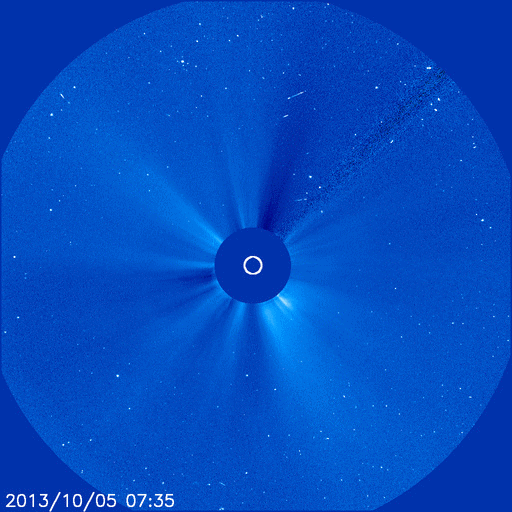 News Posted Today: October 4, 2013 Donations Needed for Eclipse-Glasses Effort  Astro Picture of the Day: October 5, 2013  Is it possible to image the International Space Station and transport ships that supply fuel to it from Earth? The answer is yes! The below is a passage from Philip Smith who took this image in Manorville, New York. I imaged the ISS and Cygnus spacecraft at max 85 deg.on 9-29-13 Time 6:16am EST I used my Meade 10 with a 2X barlow and an Orange Filter and Skynyx 2.0 M chip size 640x480 on CCD @ 66 FPS With Emmanuel Rietsch Tracking System Capture start time = Sunday, 29 September 2013 06:13:50 / UTC -4 Hours Capture duration = 222.45 Sec Captured frames = 14676 Capture frame speed = 66 Fps Camera = Lumenera SKYnyx2-0M pixel size = 7.40 x 7.40 µm² Image format = MONO - 12 Bit Capture format = Tif Image type = Light frame RoI size = 640x480 Frame rate = 66.6 Fps Exposure = 1.01 ms Gain = 12.8 Gamma = 1.00 Contrast = 1.00 Brightness = 1.0 Two private American companies are now responsible for hauling cargo to the International Space Station. Orbital Sciences Cygnus spacecraft attached to the orbiting laboratory today by 7:01 a.m. EST a first for the cargo ship. The rendezvous was nearly flawless, according to officials with NASA and the private company. You can also see my video. http://www.youtube.com/watch?v=4oyMZkbtMVk BR Philip Smith
__________________
1st in Kommisar's 2009 SM Tournament 1st in I Love You`s 2009 New Year`s Tournament 3rd in EnR's Mashfest '08 tournament 5th in Phynx's Unofficial FFR Tournament 9th in D3 of the 2008-2009 4th Official FFR Tournament 10th in D5 of the 2010 5th Official FFR Tournament 10th in D6 of the 2011-2012 6th Official FFR Tournament FMO AAA Count: 71 FGO AAA Count: 10 Bluearrowll = The Canadian player who can not detect awkward patterns. If it's awkward for most people, it's normal for Terry. If the file is difficult but super straight forward, he has issues. If he's AAAing a FGO but then heard that his favorite Hockey team was losing by a point, Hockey > FFR PS: Cool AAA's Terry - I Love You An Alarm Clock's Haiku beep beep beep beep beep beep beep beep beep beep beep beep beep beep beep beep beep - ieatyourlvllol |
|
|

|
|
|
#697 |
|
⊙▃⊙
|
What's in the sky tonight?
October 6, 2013 -The team flying NASA's Lunar Atmosphere and Dust Environment Explorer (LADEE) mission is among the select few at the space agency who have exemptions allowing them to work during the government shutdown. Early this morning, October 6th, they fired LADEE's main engine in a braking maneuver known as the Lunar Orbit Insertion burn. This slowed the spacecraft's velocity enough for it to be captured by the Moon's gravity. This critical burn went flawlessly and LADEE is now in lunar orbit. Two more main engine burns, on October 9 and 12 will adjust LADEE's trajectory, settling it into its commissioning orbit. LADEE is on a mission to study the diaphanous lunar atmosphere, which is mightily affected by space weather. -Jupiter is at western quadrature this week, 90° west of the Sun in the morning sky. This is when, in a telescope, the western edge of Jupiter is most clearly dimmer than its eastern, more sunward-facing edge. Astro Picture of the Day: October 6, 2013  The Gegenschein is an elliptical glow in the night sky in the antisolar point. Not to be confused with the Zodiacal Light which is a reflection of sunlight from dust directly reflecting Earth, the Gegenschein is a much fainter reflection of light reflecting back from the Zodiacal Light towards Earth. The image was captured by Yuri Beletsky in October 2007 using a digital camera with a wide-angle 10 mm and installed on a portable equatorial mount lens. The sky in this picture is about as good as it gets in regards to transparency, which helped captured the fine structure of the Gegenschein. The image was taken at the Cerro Paranal Observatory, located in the Atacama Desert in northern Chile, at an altitude of 2635 m.
__________________
1st in Kommisar's 2009 SM Tournament 1st in I Love You`s 2009 New Year`s Tournament 3rd in EnR's Mashfest '08 tournament 5th in Phynx's Unofficial FFR Tournament 9th in D3 of the 2008-2009 4th Official FFR Tournament 10th in D5 of the 2010 5th Official FFR Tournament 10th in D6 of the 2011-2012 6th Official FFR Tournament FMO AAA Count: 71 FGO AAA Count: 10 Bluearrowll = The Canadian player who can not detect awkward patterns. If it's awkward for most people, it's normal for Terry. If the file is difficult but super straight forward, he has issues. If he's AAAing a FGO but then heard that his favorite Hockey team was losing by a point, Hockey > FFR PS: Cool AAA's Terry - I Love You An Alarm Clock's Haiku beep beep beep beep beep beep beep beep beep beep beep beep beep beep beep beep beep - ieatyourlvllol |
|
|

|
|
|
#698 |
|
⊙▃⊙
|
What's in the sky tonight?
October 7, 2013 -During twilight, the waxing crescent Moon shines to the right of Venus. Well to the Moon's lower right, while twilight is still fairly bright, binoculars show Saturn above Mercury. -Comet ISON is brightening as it approaches the sun. Estimates by experienced observers put the comet between 10th and 11th magnitude. That's too dim to see with the unaided eye, but bright enough for color photography through mid-sized backyard telescopes. Michael Jäger of Weißenkirchen, Austria, observed the comet on Oct. 5th and found that it was green. To image the comet, Jäger combined multiple exposures through red, green, blue, ultraviolet and infrared filters. Details may be found here. ISON's green color comes from the gases surrounding its icy nucleus. Jets spewing from the comet's core probably contain cyanogen (CN: a poisonous gas found in many comets) and diatomic carbon (C2). Both substances glow green when illuminated by sunlight in the near-vacuum of space. 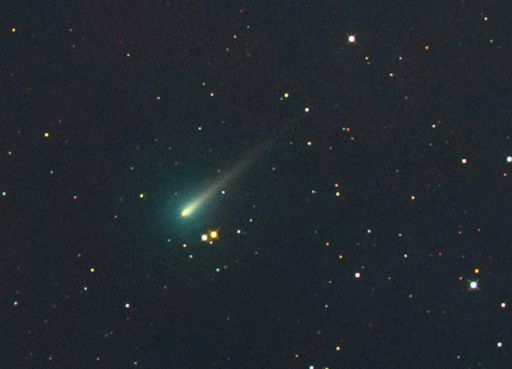 Astro Picture of the Day: October 7, 2013 .jpg) The light spectra of the zodiacal light is the same as that of the sun. A part of the light absorbed by dust is re-emittted as infrared radiation. The zodiacal light is visible to the right of this picture, as a bright, triangular shaped entity. This photo was taken just after sunset in Nambia, June 2009 in the Southern Hemisphere. While the zodiacal light is often only found in the darkest of skies, it is often referred to as the "false dawn" due to its vast luminous expanse. The zodiacal light is the brightest typically around the time of the autumnal and vernal equinoxes. Credit & Copyright: Rudi Dobesberger (Sternfreunde Steyr).
__________________
1st in Kommisar's 2009 SM Tournament 1st in I Love You`s 2009 New Year`s Tournament 3rd in EnR's Mashfest '08 tournament 5th in Phynx's Unofficial FFR Tournament 9th in D3 of the 2008-2009 4th Official FFR Tournament 10th in D5 of the 2010 5th Official FFR Tournament 10th in D6 of the 2011-2012 6th Official FFR Tournament FMO AAA Count: 71 FGO AAA Count: 10 Bluearrowll = The Canadian player who can not detect awkward patterns. If it's awkward for most people, it's normal for Terry. If the file is difficult but super straight forward, he has issues. If he's AAAing a FGO but then heard that his favorite Hockey team was losing by a point, Hockey > FFR PS: Cool AAA's Terry - I Love You An Alarm Clock's Haiku beep beep beep beep beep beep beep beep beep beep beep beep beep beep beep beep beep - ieatyourlvllol |
|
|

|
|
|
#699 |
|
⊙▃⊙
|
What's in the sky tonight?
October 8, 2013 -The Moon shines above Venus in twilight. Depending on where you are in North America, the Moon, Venus, and fainter Antares form a nearly equilateral triangle. -A minor CME, propelled towarded Earth by a magnetic filament erupting on the sun, could strike our planet's magnetic field during the late hours of Oct. 9th. NOAA forecasters working through the US government shutdown estimate a 30% to 40% chance of polar geomagnetic storms.  Astro Picture of the Day: October 8, 2013 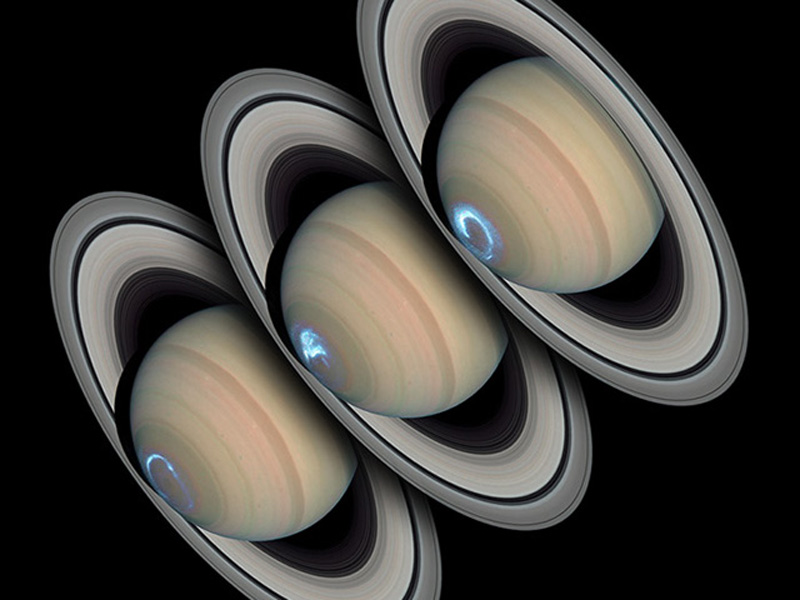 Earth is not the only planet in the solar system to be struck by the sun's radiation. Planets as far as Saturn have been known to form auroras. This sequence of three images taken by Hubble Space telescope of Saturn was taken over two day intervals. The auroras are caused by charged particles entering the atmosphere of Saturn, much like how it happens on Earth. Auroras have also been discovered on Jupiter.
__________________
1st in Kommisar's 2009 SM Tournament 1st in I Love You`s 2009 New Year`s Tournament 3rd in EnR's Mashfest '08 tournament 5th in Phynx's Unofficial FFR Tournament 9th in D3 of the 2008-2009 4th Official FFR Tournament 10th in D5 of the 2010 5th Official FFR Tournament 10th in D6 of the 2011-2012 6th Official FFR Tournament FMO AAA Count: 71 FGO AAA Count: 10 Bluearrowll = The Canadian player who can not detect awkward patterns. If it's awkward for most people, it's normal for Terry. If the file is difficult but super straight forward, he has issues. If he's AAAing a FGO but then heard that his favorite Hockey team was losing by a point, Hockey > FFR PS: Cool AAA's Terry - I Love You An Alarm Clock's Haiku beep beep beep beep beep beep beep beep beep beep beep beep beep beep beep beep beep - ieatyourlvllol |
|
|

|
|
|
#700 |
|
V's beta-male entourage
|
I love this thread. It's FFR's IFLS.
Second, that picture of Saturn 3 boobs |
|
|

|
 |
| Currently Active Users Viewing This Thread: 1 (0 members and 1 guests) | |
|
|